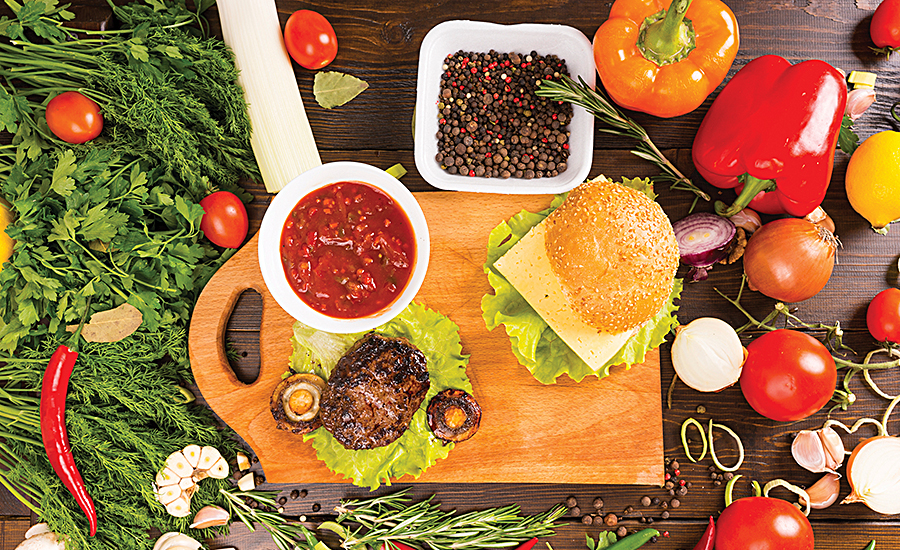Formulating Freshness in Foods
To many consumers, freshness is the ultimate in quality, but what exactly does “fresh” mean?

SOURCE: Copyright: Vicheslav

Consumers find fresh foods packaged in a simple container in the refrigerated section more desirable than a shelf-stable item.
SOURCE: Culinex LLC, (www.culinex.biz)

HPP or sterile cold fill help maintain the flavor, bright colors, and firm textures of a freshly prepared fruit or vegetable product.
SOURCE: Culinex LLC, (www.culinex.biz)

Low-moisture flash-frozen vegetables are excellent performers in products like burritos because they mimic the fresh qualities of the fresh version of the produce.
SOURCE: White Oak Frozen Foods/Cascade Specialties Inc. (www.whiteoakfrozenfoods.com)

Rosemary oils and extracts are being used to great effect as natural solutions to slowing rancidity and spoilage in meat-based dishes.
SOURCE: Culinex LLC, (www.culinex.biz)

A product like a sauce or dip that calls for adding ingredients before use requires a different approach to processing than an RTE item.
SOURCE: White Oak Frozen Foods/Cascade Specialties Inc. (www.whiteoakfrozenfoods.com)

With a packaged baked product, even slight increases in dampness and condensation can hasten mold and structural breakdown.
SOURCE: WHITE OAK FROZEN FOODS/CASCADE SPECIALTIES (WWW.WHITEOAKFROZENFOODS.COM)

Rosemary extracts have proven especially effective in preventing
rancidity—a key measure of freshness in oil-rich ingredients and products such as meats, nuts and breads.
SOURCE: CULINEX LLC (WWW.CULINEX.BIZ)








Today’s consumers, we are being told, want it all. They’re busy, so food needs to be on the table quickly. They’re tired, so meal prep needs to be simple. They’re more knowledgeable, worldly, and discerning about food than ever before, so ingredients need to be high quality. And they’re socially conscious, so the ingredients that make up those foods need to be wholesome and made with ingredients they can pronounce, while also being sustainably sourced. Above all, they expect food to be delicious, with all of the fresh, high-quality attributes found in scratch-made foods.
For food developers, the challenge is to meet this demand for foods that look, smell, and taste fresh—that hold onto their perfect texture—yet maintain extended shelf life and meet consumer demand for being “quick and easy.” A daunting prospect to say the least.
Of course, freshness is important in items like fruits, vegetables, and animal-derived proteins. And attributes such as color, sheen, blemish (or lack thereof), aroma, and firmness are the measures of freshness in produce. But how does that translate to the average shopper determining freshness on the packaged goods shelf?
Typically, the less processing that’s evident, the fresher an item appears in the eyes of the consumer. Food and beverage products with few, easy to pronounce ingredients on the label, and packaged in a simple container housed in the refrigerated section is a much fresher prospect to a consumer than a shelf-stable item.
Taking Temps
“Choosing the right processing method is just as important as the ingredients that go into your formula,” says Emily Munday, culinologist for organic and all-natural food product development consulting firm CuliNex LLC. “Processes such as hot-fill and retort can kill texture and flavor, yet they are necessary for some products to achieve desired shelf life as well as to guarantee food safety. However, choosing a manufacturing method that will provide the desired shelf life, and provide fresh flavor—for example, high-pressure processing [HPP] pasteurization or a sterile cold fill—the end product will benefit.”
Such “gentler” processing methods can be tricky, requiring balancing of pH and water activity to ensure freshness and safety. However, for products like salad dressings, sauces, and soups, HPP or sterile cold fill can be invaluable for maintaining the flavor, bright colors, and firm textures of a just-prepared product.
Heat steps aren’t the only processing steps that need a review when preparing a formula for mass production. Cool-down steps are equally important. Chilling and freezing methods can affect texture, color, and flavor just as easily as does a heat kill-step. While a long, slow cooling tunnel, for example, might be ideal for carefully freezing a product to ensure safety, slow-forming ice crystals will cause cells to rupture, while air from fans can dry surfaces and dull color. Better methods for preserving freshness could be flash-freezing or IQF.
“Temperature at every step of the process plays a crucial role in controlling freshness,” states Kimberly Schaub, Certified Culinary Scientist (CCS) and product development manager for Richville, Calif.-based Lundberg Family Farms Inc. “When we process rice cakes, even the temperature of the facility itself is regulated.”
Schaub points out what happens when a processor packs bread or another just-baked item in a plastic bag before it’s cooled completely. Condensation fogs the inside of the bag, and the result is wet bread. Even a slight increase in dampness inside such a baked product would hasten mold and structural breakdown. “The same is true with foods like rice cakes,” she says. “If the product is too warm, if even the packing floor is too hot, the product will lose its crunch.”
End Results
The manufacturing process isn’t necessarily the end of the story, though. How the end user is going to interact with the product is one of the most important considerations when focusing on fresh. This is because how much or how little the end-user contributes to the fresh experience can vary much more widely than with a more “static” formulation.
For example, with a prepared sauce, does the consumer or production chef impart a level of control toward the fresh experience? A sauce that will invite more manipulation—say, adding proteins or fresh herb mixes or flavorants—will need to be approached quite differently from one which is merely heated and poured onto a main ingredient.
Schaub begins formulating at the outset by thinking about how the end user is going to use a product. “In a traditional flour-thickened sauce, for example, I might consider different starch systems that will perform better depending if the consumer wants to add his or her flavor component to finish or not. “It might be better to add xanthan or another gum that would allow additional liquid to be added,” she explains. “Or, conversely, it would be better to adjust viscosity if the consumer will be simmering the sauce on the stove for an extended period of time while other preparation is being done and other dishes are cooking. This would mean there’s going to be evaporation, which will ultimately thicken the sauce.”
Schaub points out the advantages of consulting with experts from starch and gum suppliers for such formulations. “I’ll walk them through our process in our facility and what I expect the end user’s process to be, how it will be re-thermed or whether it might be thinned with a wine or a milk or cream,” she says. “There are hundreds of options in the gum and starch world, so these experts are key partners to finding the end solution that’s perfect for the consumer.”
The order of each processing step is yet another important factor in maintaining product integrity. This can be especially crucial when making a complicated product that needs to maintain identifiable components. A fruit salsa would be an ideal illustration. Knowing that an essential element of freshness of a mango-pineapple salsa is the appearance of whole pieces of fresh cilantro in the finished item, the addition of fresh indicators must be carefully timed.
In this case, turning to individually quick frozen (IQF) cilantro leaves allows them to preserve more color and integrity over raw fresh leaves, which would discolor quickly. Adding the IQF herb near the end of mixing time rather than the beginning will also avoid pulverizing the bright green leaves into the mixture, rather than spreading bright green flecks throughout.
The same method can be employed to add varied sparks of flavor and texture to a finished dish. Chopped yellow onions included at the beginning of the cooking process and allowed to cook slowly will provide the mellow, sweet, earthy notes of cooked onion to soup, while green onions stirred in during the last few minutes of processing add a visual boost and provide fresh, bright onion top notes.
Other flavor contributors like fruit juice and wine might be better saved for the end of processing as well, in order to preserve fresh flavors that are destroyed by excessive exposure to heat or cold. However, with wine, consideration must be given to the residual alcohol and its effects on performance and flavor if it is not ultimately cooked off. For this reasons, suppliers specializing in providing gently reduced versions of these ingredients would be worth consulting.
Locked In
The volatile components of flavorings and colors are easily affected by processes involving heat and cold, as well as other stresses of manufacture. From processing to cooking, packaging, storage, shipping, and through shelf life, purchase and preparation, each stage presents its own challenges to the fresh and freshlike product.
Flavor and color suppliers should be able to provide advice when it comes to the chemistry of their ingredients, and how performance is affected through usage percentage, flash points and processing methods.
The product developer can take advantage of supplier-based science teams with ingredient expertise who will know their products and guide those developers to the right types and forms of color and flavor components for the processing methods and steps needed.
The goal to obtain maximum flavor and color throughout the end product’s full usage span involves walking a fine line between fresh, perishable ingredients and flavors and colors derived from simple, typically botanical, ingredients that are natural to those in the formulation. The ability to use a colorant from, say, a berry already included in the recipe, or an extract of an herb that is present in whole leaf form will support the original flavors and colors without the need for additives or extra ingredients.
Plotting out the steps in the ingredient selection process can provide a helpful roadmap. “We prefer to start with the real food first to solve development issues,” says CuliNex’s Munday. “We rely on added flavorings and colors only when a product needs a little help.” Still, she cautions, truly fresh might not always be the best option at some junctures.
“Fresh foods can pose problems when trying to manage consistency and cost. With fruits and vegetables, the developer also will have to contend with seasonality and regional differences.” The apple purchased in the last week of August will taste different from that purchased for the next batch preparation a few days later, even if the supplier is sourcing from the same grove.
Also, with produce, in off seasons costs rise as product quality fades. “It can seem nearly impossible to control cost and quality with a fresh-picked product,” adds Munday.
Even in a fully cooked batch sauce from fresh ingredients, variations abound even within sources of good quality ingredients. While it’s laudable to contemplate making grandma’s pasta sauce from fresh, vine-ripened tomatoes, picked fresh from the field year round, the reality is that tomatoes aren’t at their peak year-round. And, in spite of decades of botanists’ efforts, the hot-house varieties still have a hard time measuring up to tomatoes (or any other produce) grown outside under the sun.
In contrast, an aseptic-packed tomato purée produced by a manufacturer in the field will be picked and processed at its peak, within yards of where it grew. Although it might sit in dry storage for months or even years, it can provide the high quality, consistent flavor of a fresh tomato. Bonus: It will do so without the cost, labor, and waste of bringing in fresh but sub-par tomatoes during the off-season.
Fresh Frozen
While IQF fruits and vegetables have been in common use for decades, they suffered a problematic history because of moisture migration. This would affect not only texture but also leached flavor and color as the moisture left the product in use. But science has been catching up to demands for better quality frozen foods, with new methods of freezing fruits and vegetables in the form of low or reduced moisture IQF produce.
The most modern processing methods take fresh produce, picked at its peak, and cut it to uniform size. The product then is run through a belt dryer to reduce partially remove by 30 to 50% of the moisture. At this point, the produce can be either pasteurized to make it ready to eat (RTE) or it can be otherwise processed to suit a specific need. For example, fire-roasting tomatoes or corn for added flavor, after which the vegetables are pasteurized.
The resulting, intensely flavored and colored produce pieces are then flash-frozen to seal in the freshness factor. The final ingredient product will both look and taste fresh at the time of use, plus the reduced moisture means less syneresis (weeping), better flavor. It also will have preserved a remarkably fresh texture and appearance for a frozen product.
According to culinologist Katherine Langel, also at CuliNex, such ingredients have enormous benefits. “Not only do such ingredient products look and taste great, they perform like fresh produce,” she says. “The processors don’t have to do a thing to them—they can go right into the finished formulation without additional work, especially as they’ve already gone through a kill step.”
These low-moisture frozen vegetables are excellent performers in RTE items like salsas, relishes, and dips. They also allow processors to raise the bar for Home Meal Replacement (HMR) products like burritos, enchiladas, lasagnas, and other pasta dishes because they mimic fresh texture, flavor, and color of the fresh version of that produce. An additional benefit to these low-moisture frozen ingredients is that they also save freight and storage costs because the losses are merely water—always a costly fraction to ship and store.
The Boost
Whether or not a product developer chooses to boost a formula with added flavors or colors is up to the developer and the choices for clean options are extensive. The best option, though, is to use these additives as enhancers and not rely on them to provide the essential attributes of the final product. When a boost of flavor or color is needed, avoid the one-size-fits-all approach.
“You can’t usually get the flavor boost you want from just one ingredient or product,” says Munday. “Playing with a few flavors, maybe an oil to provide a good base flavor paired a water soluble essence to add depth and an alcohol-based flavor to provide finish is needed to get the fresh flavor you want. You have to do a certain amount of experimenting.”
If whole ingredient options simply won’t work alone, it might be necessary to turn to functional ingredients to help preserve the well-developed product and its fresh appeal. Ingredient scientists have been taking advantage of natural preservers of flavor and color developed in recent years. These include such functionals as antioxidants derived from botanicals.
One such antioxidant increasing in popularity is rosemary extract. As with most antioxidants commonly derived from plants (such as still widely popular vitamin E tocopherols, rosemary extracts are clean-label alternatives to other less desirable antioxidants like BHA. They help stave off fat oxidation, which leads to rancidity and causes off-flavors in a product.
Mitigating fat oxidization is of particular importance in meat products, such as sausages, which often are formulated with a considerable amount of fat. A small quantity of oleoresin of rosemary contains enough carnosic acid to bind metal ions such as iron and slow the rate of rancidity in the links. Rosemary oils and extracts are also used to slow rancidity in rice blends, whole-grain bread, and meat dishes.
Natural acids and acidifiers also are excellent ways to help control pH while also lending pleasantly fresh, tart notes to foods and beverages. Best of all, it’s fairly easy to find a great match for the end product’s flavor parameters among the range of clean label natural acids available. Citric acid derived from its namesake citrus fruits can be a perfect match in foods with orange, lemon, or lime flavors while lactic acid from milk adds noticeable fermented dairy notes to products containing milk or cheese.
Malic acid (from apples and plums) and tartaric acid (from grapes), while derived from fruits, only carry subtle notes of those fruits. This makes them neutrally flavored additions to the natural preservation arsenal.
Using a few natural acids in combination can offer an excellent blend of beginning, mid-point, and lingering tartness. In addition to their pH balancing properties and flavor contributions, acids also help control the evaporation of volatile ingredients, thus helping boost staying power of flavors and aromas in the finished product.
Wet Works
Moisture retention is paramount for keeping the perceived freshness of all types of foods. While in conventional food manufacturing practices, products such as phosphates are employed to retain water in meats, clean label savvy consumers are beginning to turn away from phosphate-laden foods.
The humble dried plum can provide a clean alternative to phosphates, as it contains high levels of the polyol sorbitol. This sugar alcohol has similar properties to phosphates, binding and trapping moisture within meat products. The high sorbitol also provides excellent moisture retention in baked goods, while the high levels of malic acid in dried plums also offers strong antioxidant properties.
Packaging, too, plays an important part in preserving texture, preventing spoilage, and retaining fresh attributes. Nitrogen flushing helps control oxidation and bacterial growth, both of which affect fresh flavors and textures. Crispness and crunch can be preserved in metalized film. Silica gel or iron packets can also be a viable solution for keeping the packaging environment dry, and oxygen-free, although these can sometimes conflict with consumer perceptions.
Says Lundberg Farms’ Schaub, “Lundberg doesn’t use silica gel packs—our customers don’t respond well to them, especially in an organic product. There’s something about ‘Do not eat this packet’ that doesn’t sit well with them.” Schaub turns to foil or metalized film to keep the crunch and hard bite in products like Lundberg’s rice cakes.
With so many things to consider, formulating for freshness can pose challenges, especially for the clean-label developer. “Developers really have to use their whole product arsenal,” says Munday. “There isn’t going to be one single thing that guarantees freshness or fresh attributes in any processed food or beverage. It’s important to assess the key product markers, shelf life goals, processing points, and packaging needs first, then develop a holistic approach to creating and preserving the fresh qualities that took so much work to develop.”
Originally appeared in the July, 2016 issue of Prepared Foods as Formulating Freshness.
Fresh and Meaty
Formulating with fresh-frozen animal proteins can also benefit flavor and consistency. In many cases, as it is with fish, unless to the processor is hooking the fish out of the water personally and preparing it immediately, it’s possible to obtain a much fresher flavor and texture from a supplier that’s caught, cleaned, and flash-frozen the fish right on the boat. In many applications, this flash-frozen fish can actually be cooked from frozen as well, further retaining its fresh attributes.
The same concept works for beef, pork, and poultry. Bringing these items into the plant refrigerated can be problematic, and unless the facility is designed to handle and quickly process fresh meat, processors run the risk of fat oxidation, product spoilage, and warmed-over flavors from meat stored past its prime. With flash-frozen product, an extra level of freshness is built in, as the product has gone through fabrication and processing within hours of harvesting, ensuring a fresher tasting result.
Looking for a reprint of this article?
From high-res PDFs to custom plaques, order your copy today!














